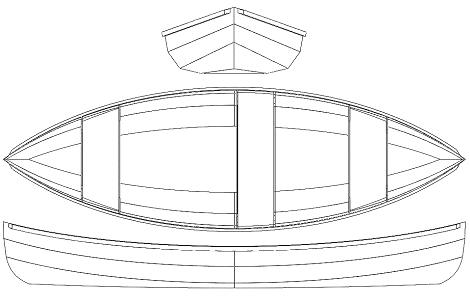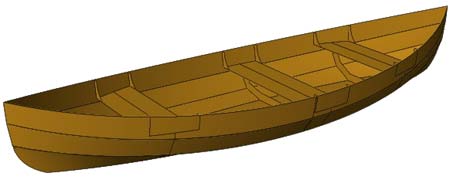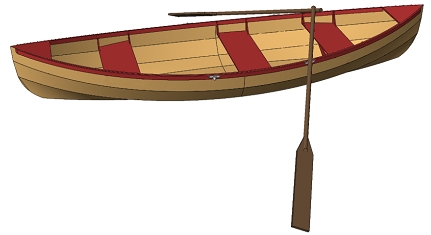|

In the 1940s and 1950s, Walter McInnis
was known as one of United States' leading designers
of large power craft. Also an avid fly fisherman,
McInnis desired a small row boat to explore streams
and other shallows that power boats could not get
to. He designed the "voyageur's bateau" as
a hunting and fishing row boat as a replacement to
the standard canvas canoe.
The hull was to be light enough to cartop by still
large enough to be stable for fly fishing and provide
the capacity to haul out deer and other game.
We modeled our McInnis Bateau to stay as to true
to McInnis' original design as possible while making
the most economical use of modern materials.

The design features a symmetrical hull
shape which means the boat is the same front and back.
This makes drawing and cutting out the panels easier
and also offers predictable performance on the water
should you need to change direction.
The double-pointed-end, canoe-like,
design will allow quiet and efficient movement through
the water. Rocker is minimal on both ends making this
row boat more suitable for lakes and streams rather
than large, open water.

There are 2 rowing positions to accommodate
for solo rowing and also taking passengers along.
Tandem rowing would be difficult with this design.
The hull is assembled using the stitch-and-glue
method of building. This method is very user friendly.
While the design is easy enough for a careful first
time builder, we recommend considering a simpler project
like a pirogue or boat-shelves first.
|
Overall Length |
12'6 |
3.8 m |
| Max. Beam |
46" |
117
cm |
| Height at bow/mid/stern |
22"/14"/22" |
65/36/65 cm |
| Recommended maximum
weight on board |
800 lbs |
363 k |
| Estimated weight* |
65 lbs. |
30 k |
*Weight of hull: Hull weight
will depend on chosen build options, quality of
materials used and skill of the builder.
Always wear your Personal Floatation Device!

Cost to build start at about $350-$400 and goes up
depending on the materials selected.
Labor:
The hull will required about 65-85 hours to complete.
These times are rough estimates and will vary according
to the skill of the builder. Please note these are
"hands on" hours and do not include the time waiting
for epoxy to cure.
More:
Visit our Customer
Service Forum to ask questions or see
what others are saying about this design.
Plans
Packing List:
-
Simple to follow, detailed drawings
of each part with all dimensions required to
layout and cut from flat plywood sheets.
-
Nesting drawings for the best
plywood layout with all panels clearly labeled.
-
Drawings list
-
Specific and highly detailed
building manual for this boat. 42 pages in all!
-
Bill Of Materials.

|